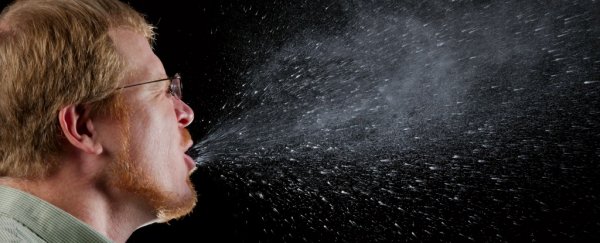Researchers have developed a new technique to study how a common disease causing bacterium can spread and remain in the environment after coughing or sneezing – and the results are not pretty.
The team has found that a subset of pseudomonas aeruginosa, a bacterial species associated with hospital infections, expelled from a sneeze or cough has a half-life of 10 minutes, and can still hang around for 45 minutes after.
"Our previous research had found that these pathogens travelled up to 4 metres and stayed viable for 45 minutes after being coughed into the air," Lidia Morawska, co-lead researcher at the Queensland University of Technology (QUT), said in a statement.
"We wanted to find out how bacteria-carrying droplets expelled by sneezes or coughs travel such distances and remain able to infect other people after such a long time."
P. aeruginosa bacteria is a common, multidrug resistant pathogen, which can cause hospital infections such as ventilator-associated pneumonia and sepsis.
The bacteria normally only causes disease in those with existing diseases or conditions, especially cystic fibrosis.
Although these kinds of bacterial species have been quite well studied, we still don't fully understand how a sneeze or cough can spread the infection.
"Most research in this area to date has focussed on laboratory-generated bio-aerosols, or airborne droplets, which are different from natural respiratory droplets generated by humans in composition and mechanisms of production," said Morawska.
"We developed a novel technique to target the short-term and long-term ageing of bio-aerosols from people, without contamination from the ambient air."
The technique from the QUT team, called Tandem Aged Respiratory Droplet Investigation System, or TARDIS, allowed the researchers to investigate how aerosols from a sneeze or cough spreads, and then sticks around – and for how long.
"To demonstrate the technique, airborne cough droplets were sampled from two patients with cystic fibrosis and chronic pseudomonas aeruginosa infection," said Morawska.
"As soon as cough droplets hit the air they rapidly dry out, cool and become light enough to stay airborne. They also partly degrade through contact with oxygen in the air, with larger droplets taking much longer to evaporate."
Most of these droplets degrade enough that the bacteria cannot survive inside them – usually very quickly.
The researchers found that most of the bacteria in the dried droplets died or decayed with a 10 second half-life, but a smaller subset of the bacteria had a half-life over 10 minutes.
"This suggests some of the pseudomonas aeruginosa bacteria are resistant to rapid biological decay and thus remain viable in room air long enough to form an airborne infection risk, especially to people with respiratory problems such as patients with cystic fibrosis," said Morawska.
Although the researchers are not quite sure why this occurs, they hypothesise that it is related to where the droplets are being produced in the respiratory track, and the size of the droplets themselves.
"We think this could be because droplets are produced in different parts of the respiratory tract and carry different 'loads' of bacteria," said Morawska.
"The larger droplets carrying bacteria take longer to evaporate which makes them more resistant to decay and able to maintain bacteria viability for extended periods."
Either way, this research has important implications for infection control in hospitals, and it also provides yet more evidence to back up the eternal warning – cover your mouth when you sneeze and cough, and wash your hands afterwards.
Queensland University of Technology is a sponsor of ScienceAlert. Find out more about their research.
